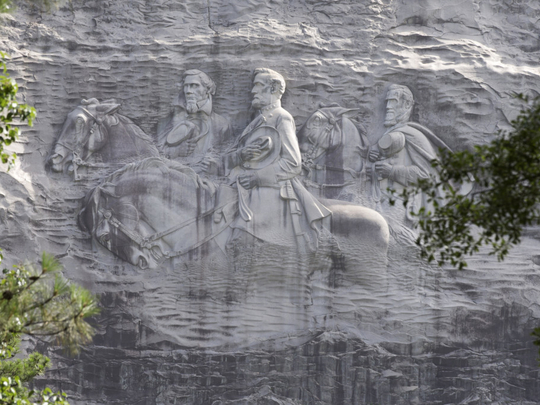
Activists in Durham, North Carolina, tired of waiting for local leaders to decide what to do about a statue of a Confederate soldier downtown, recently literally took matters into their own hands, yanking it off its pedestal and then kicking it, as if trying to beat it into submission. A North Carolina law passed in 2015 prohibits the removal of these monuments, yet the prospect of being prosecuted for doing just that was not a deterrent.
Once again, America is having a national debate on the hundreds of Confederate monuments that stand across the South — inspired, this time, by last weekend’s march in Charlottesville, Virginia, when white supremacists protested the city’s plan to move a statue of Robert E. Lee.
White supremacists aren’t the only defenders of these monuments. United States President Donald Trump on Tuesday criticised efforts to take them down. “This week, it is Robert E. Lee and this week, Stonewall Jackson,” he told a news conference. “Is it George Washington next?” Some say they are about heritage and history, not racism; others say we need to keep them in place to remind us of our dark past.
Confederate apologists in the South and around America have rallied behind such monuments since they first went up in the late 19th and early 20th centuries. They recast Confederate soldiers as heroes fighting not for the institution of slavery but for the “Lost Cause”, the mythology of the Confederacy as a grand patriarchal civilisation.
The Charlottesville march, with its hundreds of neo-Nazis and white nationalists coming out to defend the memory of Lee, puts the lie to the notion that, as the apologists say, these monuments are about “heritage, not hate”.
This is hardly new. Confederate monuments have always been symbols of white supremacy. The heyday of monument building, between 1890 and 1920, was also a time of extreme racial violence, as Southern whites pushed back against what little progress had been made by African Americans in the decades after the Civil War. As monuments went up, so did the bodies of black men, women and children during a long rash of lynching.
In the civil rights era, segregationists again sought to push back any attempt to challenge white male supremacy. Once again, they rallied under the banner of the Confederate battle flag. But this time, local and state officials from law enforcement and state agencies like the Sovereignty Commission in Mississippi joined them in their effort.
Today, the battle for white male supremacy has expanded in scope. It is nativist, anti-feminist and anti-Semitic. It is also homophobic. As always, it is racist. And it has fully embraced the imagery of Nazism, from Adolf Hitler to swastika flags to the Nazi salute.
Confederate “heritage”, as a unifying theme for the white South, also obscures the way that white elites use the white working class to do their bidding by pitting them against those with whom they have more in common economically than those in power. The path for the rise of the Southern Democratic Party, known as the “White Man’s Party”, was paved with racial violence. White elites showed their thanks by erecting Confederate monuments.
This isn’t just a Southern problem. During the presidential campaign, and now from the seat of power in the White House, Trump’s talk of building a wall and his circle of nationalist advisers embolden the very people who showed up in Charlottesville.
And once again, rather than seeing clearly that Confederate monuments stand at the very centre of the white-supremacist imagination, too many people are clouding the issue. Some of my fellow historians have naively suggested that we need to keep them to teach us the darker lessons of Southern history. But at what cost? What the events of this past week have made clear is that for several generations, the Lee monument and others like it have assisted the cause of white supremacy and the deadly violence that has accompanied it. This is why communities across the region have a moral obligation to take up the cause of removing them. Artefacts of hate will be lost, but their history and meaning will not.
While what happened in Charlottesville is a stain on the American nation, one should remain hopeful for the future. Those who gathered in the name of hatred and bigotry did so under the banners of defeated regimes. This does not bode well for their cause. Truly patriotic Americans, of all colours and creeds, can and should stand up to them as they did this past week. But there is also need for leadership at all levels of government to condemn not only their actions, but also white supremacy itself.
— New York Times News Service
Karen L. Cox is a professor of History at the University of North Carolina, Charlotte, and the author, most recently, of Goat Castle: A True Story of Murder, Race and the Gothic South.









